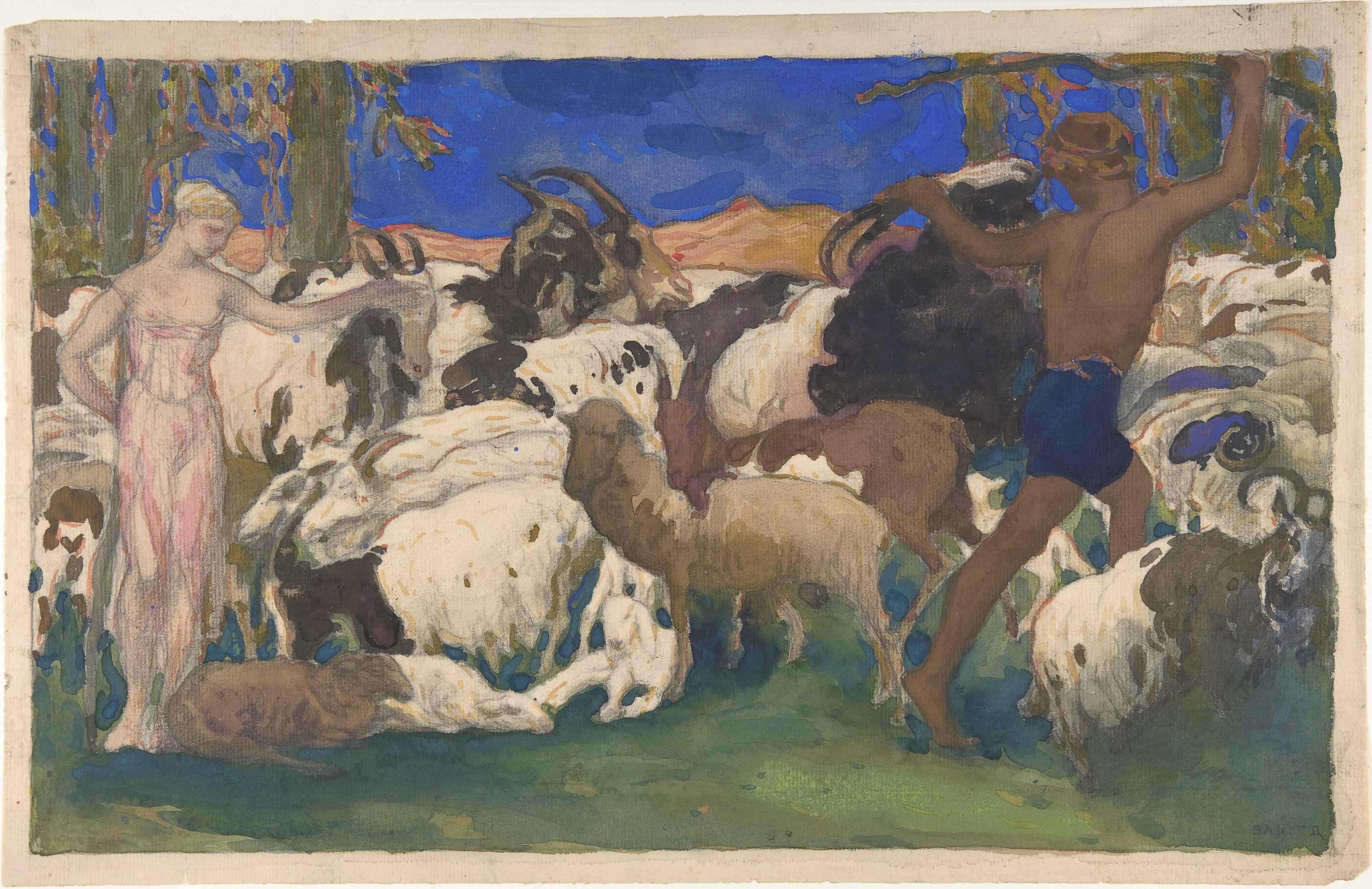-
03
-
03
-
03
-
03
-
03
-
03
-
03
-
03
-
03
-
03
-
03
-
03
-
03
-
03
-
03
-
03
-
03
-
-
-
03
-
03
-
03
-
03
-
03
-
03
-
03
-
03
-
-
03
-
03
-
03
-
03
-
03
-
-
03
-
03
-
03
-
03
-
-
03
Ravel and the Russians: Echoes in Modern Media and Film Scores
Monday, July 14, 2025
Posted By:Jessie Fillerup
—

Landscape with Shepherds, set design for Daphnis and Chloé, 1911 (watercolor) by Léon Bakst. The Metropolitan Museum of Art, gift of Sir Joseph Duveen.
One hundred and fifty years after his birth, Maurice Ravel is everywhere and nowhere. Composers and musicians from many walks of life—Frank Zappa, Stephen Sondheim, Alexandre Desplat, and Miles Davis, to name a few—have openly acknowledged the composer’s influence. Ravel’s String Quartet, the Pavane for a Dead Princess, the Adagio from the G major piano concerto, and, of course, the hauntingly insistent melody of Boléro have appeared in films, TV series, commercials, and at least one memorable Olympic ice dancing routine. But if Ravel’s music is instantly recognizable, his name, to many listeners, is not.
The reasons for this are many. For a long time, Ravel played second fiddle to his older contemporary, Claude Debussy, who had pioneered a gossamer sound and a free-floating harmonic language that became synonymous with French music in the late nineteenth and early twentieth centuries. The two composers had a tenuous relationship: Debussy once described Ravel, in a letter to the music critic Louis Laloy, as an “enchanting fakir who can make flowers spring up around a chair,” concluding that “unfortunately, a trick is always prepared, and it can only astonish once!” Ravel kept practicing his tricks and shaped his own path, sharing certain aspects of his compositional style with Debussy, yet ultimately distinguishing his music from Debussy’s with his driving and complex rhythms, finely wrought melodies, and virtuoso flourishes. His output, though relatively small, includes ballets, orchestral works, piano and chamber music, concertos, and songs; most of this music is highly regarded and widely performed today.
If his music sounds familiar, it’s not only because of the compositions that have embedded themselves in modern media. Ravel also helped to popularize certain musical gestures and sound combinations that have since become the stock-in-trade of film composers. He admired the music of nineteenth-century Russian composers, particularly Alexander Borodin and Nikolai Rimsky-Korsakov, both expressive musical storytellers whose operas and orchestral music vividly evoked faraway times and places. In Scheherazade (1888), a symphonic suite based on The Thousand-and-One Nights, Rimsky-Korsakov portrays a sea voyage with undulating arpeggios in the low strings. Sinuous melodies in the woodwinds and solo violin situate the piece temporally and geographically—in the past and in the East.
Ravel adapts these musical devices for Daphnis and Chloe, a lush ballet fantasy from which he drew the music for the second suite, composed in 1913. The Suite opens with a sensuous viola melody unfolding over rippling woodwind arpeggios, painting a pastoral sunrise scene that parallels the splendor and transcendence of a movement in Joseph Haydn’s The Creation (In shining splendor). A few sonic markers—first a circuitous oboe solo, then a choir of double reeds playing parallel fifths—place the dramatic action in time (the past) and space (an Orientalist Greece). For the Danse générale that concludes the suite, Ravel offers a virtuosic gloss on the bombastic final movement of Scheherazade, interlacing swirling woodwind solos and a bass ostinato in an off-kilter 5/4 meter.
A version of the second suite includes wordless chorus, a sound Ravel had encountered in Debussy’s Sirènes (1901). In Daphnis, Ravel’s chorus has a malleable timbre, resonating like a pipe organ or shimmering like a dozen harps, adding to the music a heightened sense of mystery and drama. Film composers quickly assimilated the wordless chorus into their lexicon, finding it especially suitable for scenes of cosmic or enigmatic wonder. A scene in Steven Spielberg’s Jurassic Park elicits both sentiments when two scientists played by Sam Neill and Laura Dern first witness a massive brachiosaurus lumbering through a meadow. John Williams, who wrote the film score, accompanies the scene with a tuneful, singable melody (familiar as the “Jurassic Park” theme); a wordless chorus in the background provides a magical, aural glow.
Some of the best-known film composers of the early and mid-twentieth century—including Franz Waxman, Miklós Rózsa, Max Steiner, and Erich Korngold—were European emigrés trained in the classical style. Much of their harmonic language was rooted in the music of Richard Wagner and Richard Strauss, but their approach to orchestral sound and instrumentation was distinctly Francophile, employing strategies popularized by Ravel and Debussy. Ravel linked specific sounds and gestures, like the harp glissando, to exotic fantasies, magical events, and alternative modes of perception. In pieces like Daphnis, harp glissandos contribute to a dream-like or fantasy atmosphere, often signaling magical transformations or disruptive shifts in mood or tempo. Other instruments prized for their special timbre, like the celesta or glockenspiel, also functioned as magical emblems in Ravel’s music, continuing a tradition started by Russian composers. (Think of the distinctive celesta sound that opens Tchaikovsky’s “Dance of the Sugar Plum Fairy,” from The Nutcracker—a sound John Williams would borrow for “Hedwig’s Theme,” from the score for Harry Potter.)
Film composers took these trends and ran with them. Alfred Newman and Bernard Herrmann’s score for The Egyptian (1954) features a catalogue of mystical, exoticized sounds, from harp glissandos and sensuous string melodies to wordless women’s chorus. Rózsa’s music for the Dali-designed dream sequence in Alfred Hitchcock’s film, Spellbound (1945), includes swirling glissandos on the harp and the theremin, an electronic instrument that Ravel had championed. Hidden within Jerry Goldsmith’s score for the animated film The Secret of N.I.M.H. (1982) is a virtual paean to Daphnis: ripping harp flourishes, wordless chorus, and extended harmonies recall the enchanting sounds of the ballet and reflect Ravel’s lifelong interest in child-like wonder and fantasy. A century and a half after his birth, Ravel’s sound is still everywhere—even if his name is isn’t.
You can hear Fabien Gabel conduct the Aspen Festival Orchestra in Ravel's Daphnis and Chloe Suite No. 2 on Sunday, July 20, at 4 pm in the Klein Music Tent.

Dr. Jessie Fillerup is Associate Professor of Music at the University of Richmond. She is currently researching music and sound design in magic shows from the nineteenth century to the modern era, which she will be exploring in a new book, Enchanted: Music, Stage Magic, and Illusory Technologies. In her first book, Magician of Sound: Ravel and the Aesthetics of Illusion (University of California Press), she examined illusory effects in the orchestral and vocal music of the French composer Maurice Ravel. Her other publications in leading musicology journals have focused on French music, opera, and musical temporality.
-
03
-
03
-
03
-
03
-
03
-
03
-
03
-
03
-
03
-
03
-
03
-
03
-
03
-
03
-
03
-
03
-
03
-
-
-
03
-
03
-
03
-
03
-
03
-
03
-
03
-
03
-
-
03
-
03
-
03
-
03
-
03
-
-
03
-
03
-
03
-
03
-
-
03